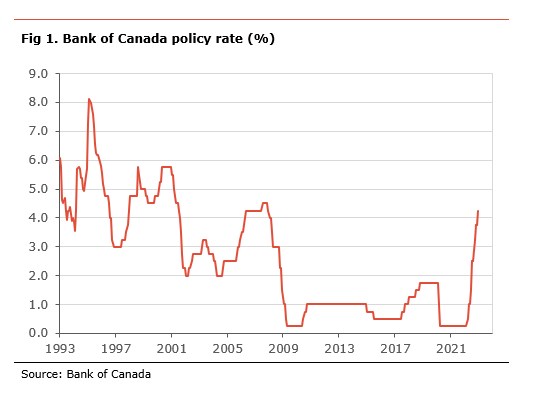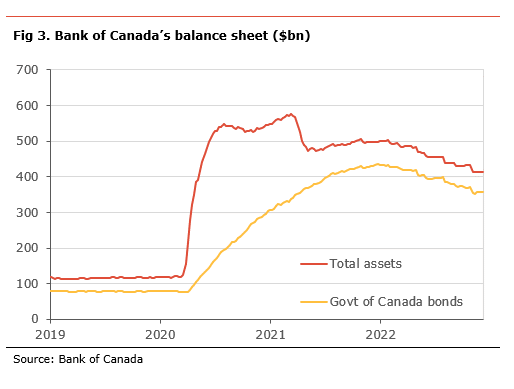Economic insight provided by Alberta Central Chief Economist Charles St-Arnaud.
Bottom line
The Bank of Canada increased its policy rate by 50bp, in line with our expectations, to 4.25%, its highest level since December 2007. The central bank also announced that it would continue quantitative tightening (QT). So far this year, the BoC has increased its policy rate by 400bp, the fastest pace since the mid-1990s.
The key message in today’s decision is that the central bank remains committed to fighting inflation but that we are at or very close to the peak in interest rates. As such, the BoC signals that whether further hikes are required will depend on incoming data-dependent. In our view, it means that if inflation continues to show signs of peaking and losing momentum and see some loosening in the labour market, the BoC will leave interest rates unchanged.
Today’s decision supports our view that the BoC is likely done with its tightening. As such, we believe that interest rates will stay on hold for at least the first half of 2023, as we believe that inflation has likely peaked.
The BoC increased its policy rate by 50bp to 4.25%, in line with our expectations. It also continued its quantitative tightening policy. The statement shows that interest rates are close to their peak, with the BoC saying that “whether the policy interest rate needs to rise further to bring supply and demand back into balance and return inflation to target”. In other words, any changes in monetary policy will be data-dependant, adding that the “Governing Council continues to assess how tighter monetary policy is working to slow demand, how supply challenges are resolving, and how inflation and inflation expectations are responding.”
The BoC took note of the weaker momentum in core inflation, but notes that the level of both headline and core inflation remains too high. The BoC notes that “CPI inflation has declined from 8.1% to 6.9%, primarily due to a fall in gasoline prices. However, price pressures remain broadly based, with two-thirds of CPI components increasing more than 5% over the past year.” Moreover, the central bank notes that measures of core inflation have not yet slowed and that inflation expectations remain high
The BoC acknowledged that growth in the third quarter was stronger than expected and that “the economy continued to operate in excess demand.” The central bank points to labour market that remains tight with a low unemployment rate as evidence of this. The BoC also points to moderation in consumption and housing market activity, as growing evidence that tighter monetary policy is holding back domestic demand. The central bank expects that “growth will essentially stall through the end of this year and the first half of next year.”



Independent Opinion
The views and opinions expressed in this publication are solely and independently those of the author and do not necessarily reflect the views and opinions of any organization or person in any way affiliated with the author including, without limitation, any current or past employers of the author. While reasonable effort was taken to ensure the information and analysis in this publication is accurate, it has been prepared solely for general informational purposes. There are no warranties or representations being provided with respect to the accuracy and completeness of the content in this publication. Nothing in this publication should be construed as providing professional advice on the matters discussed. The author does not assume any liability arising from any form of reliance on this publication.
Alberta Central member credit unions can download a copy of this report in the Members Area here.